
Features
Finding ways to get out of the woods at the 2023 TLA convention
‘The industry is in crisis’, says B.C. Premier David Eby
February 23, 2023 By Jennifer Ellson
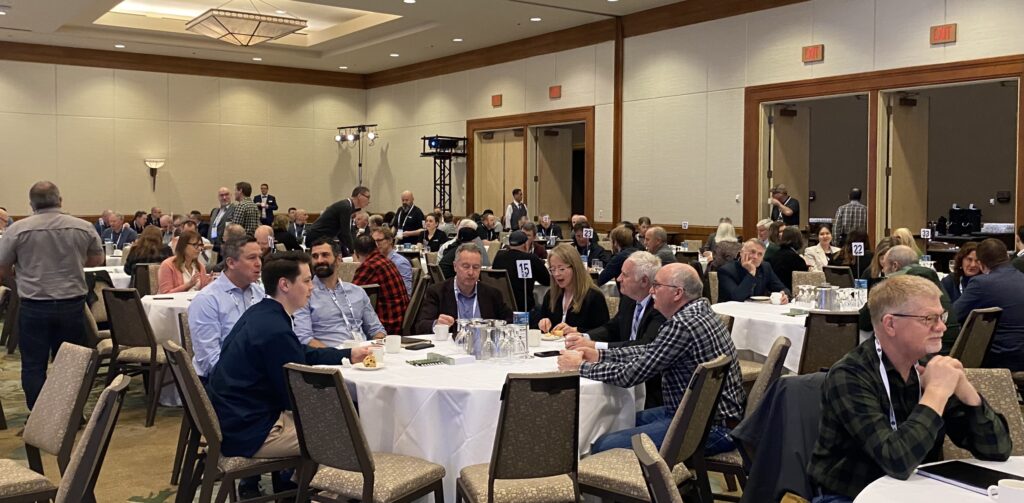 Full house at the 2023 Truck Loggers Association convention. Photo: Annex Business Media.
Full house at the 2023 Truck Loggers Association convention. Photo: Annex Business Media. The current challenges facing British Columbia’s forest industry was the focus of this year’s Truck Loggers Association (TLA) convention and trade show, which saw more than 1,000 delegates attend in person at Vancouver’s Westin Bayshore Hotel from Jan. 18-20.
“Firmly planted. Standing strong” was the theme for the 78th annual convention, which TLA executive director Bob Brash said was fitting given the current climate of the industry. “The industry, like the trees, is resilient and standing strong against the many challenges,” he explained.
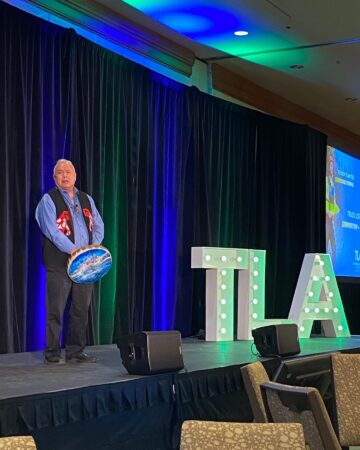
Elder Dennis Joseph from the Squamish Nation during a traditional welcome ceremony. Photo: Annex Business Media
Elder Dennis Joseph from the Squamish Nation provided a traditional welcome ceremony with a blessing and opening ritual to start the event.
“We’re at a time of reconciliation. We welcome you and we call on all our ancestors to guide us,” he said.
TLA president Aaron Service then kicked off the convention by welcoming the attendees, acknowledging the difficulties that the industry is facing, and highlighting the sector’s importance in the B.C. economy.
“We’re navigating issues and uncertainties in the industry, which is not surprising. The entire industry is suffering,” he said. But he reminded the audience that forestry is a pillar of British Columbia’s economy that supports rural communities. He added that B.C. has a lot of small contractors that are the backbone of a healthy forest economy and the government must ensure that the policies are also serving the small contractors well.
“We need the entire sector to be operating or we’re going to be in trouble,” Service said. “Over the next three days, we will discuss solutions,” he added.
A futurist’s look at forestry
Keynote speaker Nikolas Badminton said this was the trickiest keynote he had to write so far, since the industry, and the world in general, have to have a sharp focus on creating resiliency around some of the biggest challenges right now: climate, affordable energy, food supply, among others.
“We’re on life support. We’re constantly upgrading. Things are not easy, the future is not convenient,” Badminton sighed.
But anticipation is the key, he said. The most powerful companies are those who are able to anticipate and speculate what comes next.
“I don’t make predictions. I speculate,” he said.
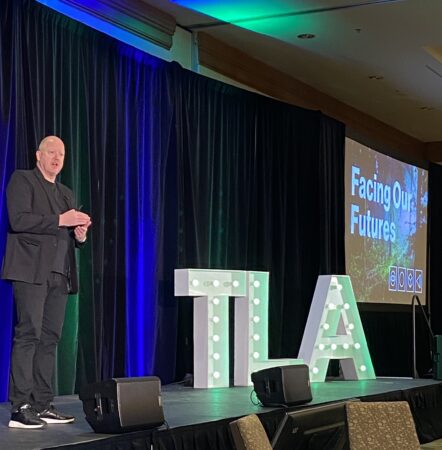
Keynote speaker Nikolas Badminton. Photo: Annex Business Media
“Foresight is the missing link between our futures and strategic planning. If you’re vigilant, you’re more profitable.”
He ended by saying companies will be changing their business models in the future, and rethinking what we do, exploring the “what ifs” can lead to innovation.
“Anticipate what’s needed. That’s how we get a step up from other companies.”
When asked a question from the audience, about artificial intelligence replacing jobs, by event moderator and renowned journalist Vaughn Palmer, Badminton said the industry needs to work hard to change that perception.
“Machines do not put humans out of work. We need to change the idea that AI is replacing humans,” he said. “Instead, we should think about what we can invest in to improve our businesses.”
Gloomy economic outlook
Russ Taylor with Russ Taylor Global opened the B.C.’s Market and Investment Climate session saying that the U.S. housing market is a key indicator for lumber demand and that softwood lumber consumption is expected to see flat growth in 2023.
“We don’t have enough supply to feed the demand,” Taylor said. B.C.’s timber supply has already shrunk, he said, particularly in Interior B.C., due to the mountain pine beetle infestation in the 1990s and early 2000s.
Taylor then told the delegates about the tale of the two regions: the U.S. South, which is thriving, and U.S. West/Rest of Canada, which is flat. In fact, the U.S. South is a great place to invest in, hence Canadian forestry giants – some of which are B.C.-based – have been investing in the U.S. South for years.
“Mountain pine beetle was a big problem (in B.C.) then, now it’s the policies on old-growth, caribou protection, tenure transfer to First Nations, etc. It’s hard to know what 2023 will bring because of these policies,” Taylor said, adding that no major forest company in B.C. will invest more in retooling their operations until those uncertainties are cleared up.
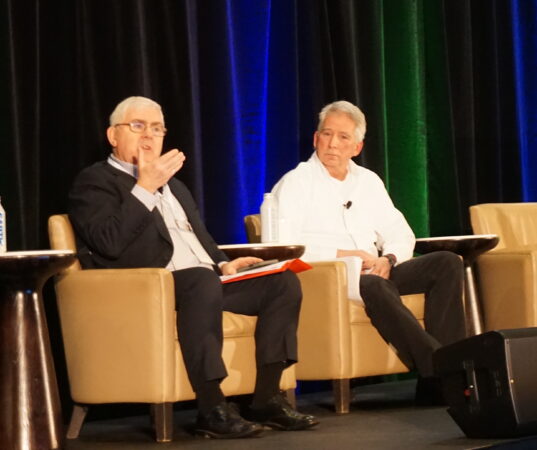
(L-R) Russ Taylor and Paul Quinn discussing B.C.’s market and investment climate. Photo: Annex Business Media.
Another panelist, Paul Quinn, paper and forest products analyst with RBC Capital Markets, agreed, saying value-added manufacturing, such as mass timber and other engineered wood products, can’t really thrive if there are no logs available.
“If the future is mass timber, you still need lumber to make mass timber,” said Quinn.
Taylor echoed Quinn’s statement. “You have to have a healthy sawmilling industry, and you have to have a fair stumpage and stable timber volumes to make the sawmill costs competitive and fair.”
Both said there will be lack of capital spending and more pulp and paper closures in B.C. within the year due to the lack of economic fibre, especially with the shutdown of several sawmills in the province, which used to provide their residues to the pulp and paper facilities.
Quinn explained that curtailments are being done by companies to keep them afloat while waiting for the market to turn around.
“The industry expects more mill closures and when that’s done, we will have a more stable industry,” Taylor concluded.
B.C.’s politics over lunch
Hard-hitting journalists Richard Zussman of Global BC and CHEK News’ Rob Shaw joined Palmer, the moderator, to discuss B.C.’s political landscape and its effects on the industry.
Zussman opened the discussion by telling the crowd what they can expect at the next day’s luncheon meeting featuring the province’s New Democratic Party (NDP) leader Premier David Eby.
“He is a quick study. He will listen and he is willing to acknowledge that he doesn’t have all the answers, but he is willing to work with you,” he said. “Unlike Horgan, he felt like he had all the answers,” Zussman joked, referring to the former premier John Horgan.
Shaw followed up with his own take on what logging contractors can expect from the premier.
“I can tell you what he will say tomorrow: ‘Yadda yadda yadda, innovation. Yadda yadda yadda, value added. Yadda yadda yadda local companies and communities,” Shaw said, to the laughter of the audience. He added that he heard that speech from Eby the day before at the Natural Resources Forum in Prince George, B.C.
Shaw did not mince words at his displeasure at how the current government is tackling the problems of the ailing industry.
“If NDP has a plan, I have yet to see it,” he said. “They don’t offer a vision of where they want to take forestry [in the future].”
“This premier is more interested in protecting old-growth forests and appealing to environmentalists,” Shaw added.
Zussman concurred saying, “It is not part of his identity of what makes B.C. great. He is all about childcare, public safety, housing, homelessness, autism.” He added that the pillars of the B.C. economy: forestry, agriculture, mining and fishing are not reflected in this government’s policies.
“[Eby] looks at forestry as a problem that can be solved quickly. But I honestly believe he’ll listen [to your concerns] and he will ask the ministers to work on [solutions],” Zussman added.
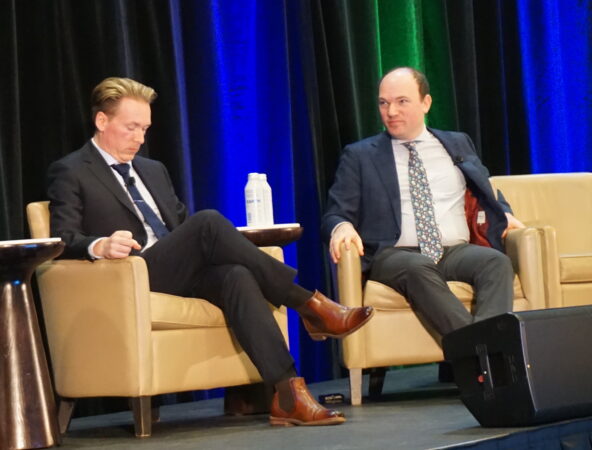
(L-R) CHEK News’ Rob Shaw and Richard Zussman of Global BC. Photo: Annex Business Media.
Role of the media
Both panelists discussed the role that the media can play in the plight of the forestry sector.
“The challenge is to provide news to those who consume our products. Do we do stories about rural communities? Rarely,” Zussman explained, highlighting the budget cuts at newsrooms everywhere due to the changing media landscape.
“It’s hard for people to relate to the industry’s problems. We’ve got to do a better job in telling stories that have real world impact,” Shaw agreed. “The media’s role has increased tenfold, so now we have no resource, no staff to report on the resource sector. We’re so busy that we only have time to cover so much.”
Palmer, the moderator, who is a multimedia journalist agreed. “Our [journalism] industry is so diminished in terms of resources. We used to go on tours and spend time at small towns to cover the news. Now [reporters] do stories by phone – big difference.”
Zussman encouraged the audience to work with the media to tell their stories.
“There’s a lot on our plate, but when people and communities reach out to us, we report on those stories,” he said. “Communicate with reporters about what your communities are experiencing. It’s a two-way street.”
During the Q&A session, the panelists were told that a lot of forestry workers hesitate to tell their stories to the media for fear of backlash from environmentalists. Shaw said “there’s lots of negativity that environmentalists managed to instill. They have the ear of this government. [The industry has to] close that loop.” He added that there has been a lot of social media bullying of workers and reporters too.
Zussman said putting the extreme in the news encourages copycats, such as some protestors chaining themselves to factory gates.
“Know that we are working on not giving them attention because it’s not helpful. We know that some environmentalists harass you because they get media attention,” Zussman said, adding that his organization Global BC is already doing less coverage of the extreme actions of some protesters.
Despite these concerns, the two journalists ended on a positive note.
“I’m sorry I’m so negative … we question the government more because of the advocacy you’re doing,” Shaw explained.
“Thanks for inspiring us to ask the ministers, based on the issues you advocate,” Zussman agreed.

Panelists at the future of technology session. From left: Moderator Vaugh Palmer; Calvin Lee from the Teal-Jones Group; Mosaic Forest Management’s Melinda and FPInnovations president and CEO Stephane Renou. Photo: Annex Business Media
Future of technology is bright
The next session on the future of technology and its use in the forest sector was filled with hope and positivity.
“We can’t dismiss the forest sector,” said FPInnovations president and CEO Stephane Renou. He added biomass is a segment of the industry that is in high demand due to the pressure to be green.
“Everybody and their brother wants to be green. Every week I have the oil industry in my office looking for biomass.”
He updated the audience on the innovations that his research organization is spearheading, including substituting asphalt with a bioproduct; addressing the labour shortage with automation and producing industrial chemicals from residues, among others.
Mosaic Forest Management’s Melinda Morben talked about supply chain efficiency, telematics and other leading technology. “Mosaic is always encouraging everyone to try the technology, float ideas – gather a team and work together for our future,” she said.
Calvin Lee from the Teal-Jones Group presented how to make logging operations more efficient via innovation like the use of drones and LiDAR, for example. The young registered professional forester was asked how the industry can attract more young workers, and he said by focusing on showing that technology and innovation are cool, and the opportunity to work outdoors.
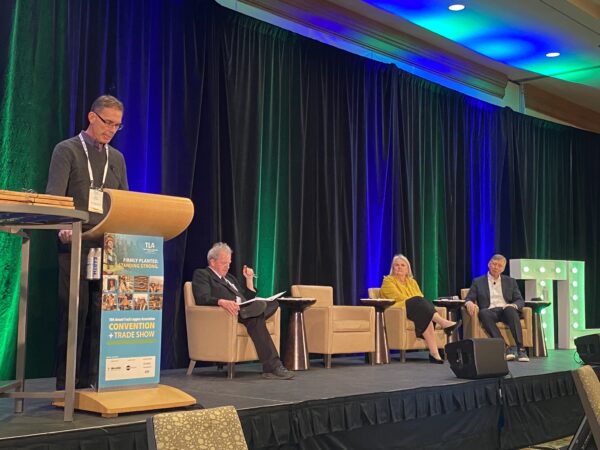
From left: Rob Moonen, CEO of BC Forest Safety Council; Moderator Vaughn Palmer; Boyden’s Catherine Van Alstine and Chris Gardner from the Independent Contractors and Business Association. Photo: Annex Business Media.
Employee mindset has changed
The day’s last session tackled workforce challenges and employee relations.
“You as employers should think about recruitment in innovative ways,” advised Boyden’s Catherine Van Alstine. This is because the mindset of employees has changed, said the managing partner of the executive search firm.
“The 19- and 20-year-olds are not thinking about ‘doing what my dad did’. Our kids don’t want to work the way we work. They don’t want to work at night or on the weekends,” she added. “They’re thinking about innovation … no more climbing corporate ladders, they’d rather build their own ladder.”
Van Alstine advocated for employers to be purposeful and open minded and consider how an employee’s life and work come together.
Layoffs are happening, said Rob Moonen, CEO of BC Forest Safety Council, but so is recruitment. However, he said the ‘Robbing Peter to pay Paula’ strategy – taking workers from competitors is not a long-term sustainable solution.
“We will require a different recruitment strategy with a focus on new and young workers.”
Chris Gardner from the Independent Contractors and Business Association said companies are saying there aren’t enough people entering the workforce in Canada. He presented possible solutions to the problem, such as tackling the backlog of immigration applications; recognizing foreign credentials; prioritizing tradespeople and speeding up immigration applications; and cutting waiting lists at trades colleges, to name a few.
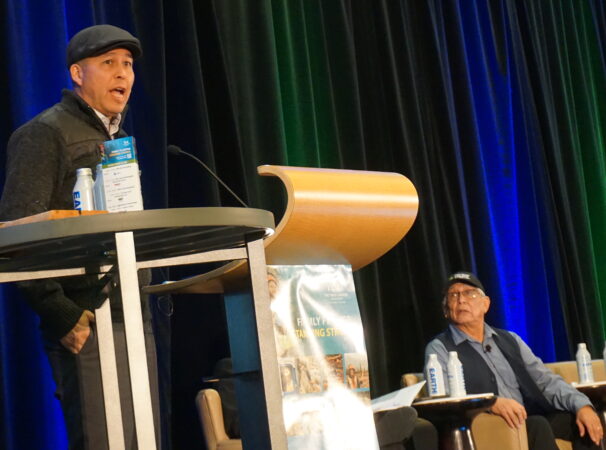
From left: Lennard Joe, CEO of the B.C. First Nations Forestry Council and Chief Robert Dennis of the Huu-ay-aht First Nation. Photo: Annex Business Media.
First Nations and forestry
Day two’s first session discussed the increased Indigenous participation in forest management.
“We are poor. We’ve been removed from the fishing industry, from the forest industry. We used to be well disposed, but now we’re one of the poorest,” said Chief Robert Dennis of the Huu-ay-aht First Nation. “If our people have well-paying jobs, a lot of social issues will go away.”
The Chief asked, “What do we have to do to be certain that we have a forest industry in our territory?” He explained that in 2019, it became “not viable for us to log, so we started knocking on the province’s door. But the province said we don’t know how to log … the province’s job is to support the citizens of B.C., and not say ‘you’re doing it wrong, this is the policy’,” Chief Dennis explained.
To the provincial government, he has a message: “Come on, we want to partner with you! We want to manage our territory, we want to renew our rivers, want to enhance our forests. That’s our goal: we want to sit down and work together.”
To the audience, his message was: “In real estate, it’s location, location, location. In forestry, it’s partnership.”
Lennard Joe, CEO of the B.C. First Nations Forestry Council, explained that in 2019, B.C. legislated the United Nations Declaration on the Rights of Indigenous Peoples and called it the Declaration on the Rights of Indigenous Peoples Act (DRIPA). Under DRIPA, any changes being proposed to forest legislation, policies and regulations require the prior, informed consent of the Indigenous People, which does not always happen.
“In 2019, the Indigenous rights became law,” said Joe, who is also a registered professional forester who works as general manager of Merritt-based Stuwix Resources. “We have our fights with industry, government. A healthy family needs a healthy fight.”
Joe said reconciliation is hard work, and some look at it as a threat. But the industry needs to have a safe room to have hard conversations. “We’re all in this together,” he said.
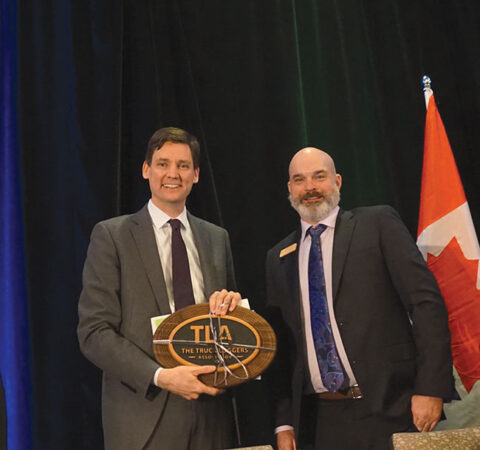
(L-R) B.C. Premier David Eby and TLA president Aaron Service.
‘The industry is in crisis’
“B.C.’s forestry industry is clearly in crisis. But crisis precipitates change and we have to find new ways of doing business,” Premier Eby told the packed ballroom during the leaders luncheon. “We’ll find that way by working together,” he added.
“For every tree harvested, we have to maximize the number of jobs that come from it. But that will only come from using our natural resources wisely.”
Eby used the convention to announce a $50 million grant to the Forest Enhancement Society of B.C., aimed at helping the industry increase the use of low-value or residual fibre, including trees damaged by recent wildfires and waste left over from logging that would otherwise be burned in slash piles. This will mean more work for forestry contractors hauling fibre, he said.
“I do recognize what’s on the line here, I know that these decisions affect your livelihood,” Eby said.
Eby also committed a $1.5 million grant to the TLA for gathering better logging data for hourly rates and productivity to better support fair and equitable contract negotiations between contractors and licensees.
The premier also mentioned the previously announced $90 million B.C. manufacturing jobs’ fund targeting rural communities that he unveiled the day prior.
“Our focus is to keep mills running, and your members working,” Eby told the convention delegates. “We know that access to fibre is one of the most critical challenges facing the industry and we’re working hard to find new sources.”
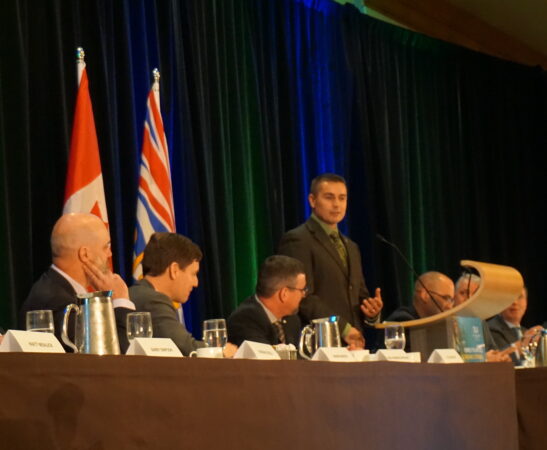
Inland Truck & Equipment’s Tracey Russell (standing) introducing B.C. Premier David Eby (seated second from left) at the TLA convention. Photo: Annex Business Media.
Honesty is the best B.C. policy
Tracey Russell of Inland Truck & Equipment introduced Eby on stage at the leader’s luncheon and used the moment to tell the premier what his fellow logging contractors are feeling.
“One thing I can tell you about this group ¬– these men and women who own these and operate these logging businesses – they like direct talk, they just want to know what’s happening,” Russell addressed Eby.
He encouraged Eby to be honest about what the future of forestry looks like under his government.
“Just tell them how it is. Even if it’s bad. They would rather have direct information, good or bad. And then they can operate their business accordingly.”
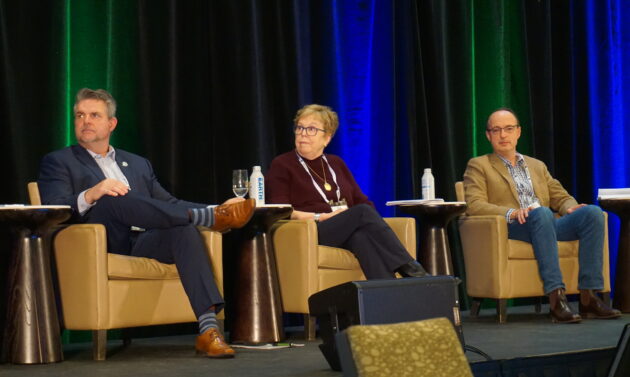
(L-R) B.C.’s chief forester Shane Berg; Linda Coady, CEO of the Council of Forest Industries; Mosaic Forest Management CEO Rob Gough. Photo: Annex Business Media.
Connect the dots
B.C. needs a strategic plan for forestry that can address the transformation of the industry and “connect the dots” between all the policy initiatives going on, such as implementing the government’s old-growth strategic review, supply and demand, investing in new technology and shifting the focus of ecosystem-based management of forests, said Linda Coady, CEO of the Council of Forest Industries.
“Other sectors have this in place … New Zealand has a really good plan,” she added during the session on new leadership moving B.C.’s sector forward.
Mosaic Forest Management CEO Rob Gough highlighted the industry’s sustainability, “It’s one thing that forestry has, and mining will never have.” He added that he is proud that Mosaic manages the natural resources on behalf of 1.6 million Canadian pensioners.
Shane Berg reiterated the previous statement by Chief Dennis that “it is the public and the Indigenous Peoples’ forests” and that his role as B.C.’s chief forester is to disseminate the facts. He then presented the facts about old-growth forests saying facts can help the forest sector move forward.
“I want B.C. to be recognized worldwide for its practices on sustainability and reforestation,” Berg said.
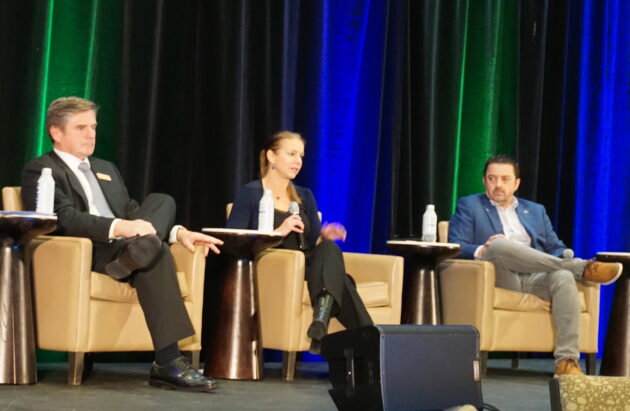
(L-R) TLA executive director Bob Brash; Shannon Janzen, former vice-president of partnerships and chief forester at Western Forest Products; Jeff Bromley, Steelworkers Wood Council chair. Photo: Annex Business Media.
The many facets of partnerships
“Allowable cuts are getting even smaller in the coming months. There will probably be contractors in this room who will not survive. Jobs will be lost,” declared Jeff Bromley, Steelworkers Wood Council chair. “I can’t make promises of no more strikes in the industry … cross those lines – that’s the key to partnership,” he added.
TLA executive director Bob Brash highlighted the forest industry’s exceptional characteristic: “it is the most sustainable building material in the world, bar none.”
Brash also rallied the audience to increase their advocacy in the forest sector. He encouraged the crowd to utilize the press and social media to increase their leverage.
“We are fighting for our right to exist. More of us have to speak up – you are a voter – clearly if there’s a time to speak up, it’s now!” He cautioned the room, however, to “be prepared for all the crap once you’re more vocal, they’ll go after you!”
Shannon Janzen, former vice-president of partnerships and chief forester at Western Forest Products encouraged the audience to advocate for the increase in participation of First Nations. With such partnerships, the forests will be managed better, she said, and if there is a stable plan that everyone can buy into, there will be more stability and the future becomes more secured.

From left: Kathy Abusow, president and CEO of SFI; Global Public Affair’s Matt Williamson; Mayor Paul Horn from Mission, B.C.
Challenges of advocacy, public education and forest literacy
Third-party audits are not immune to challenges, according to Kathy Abusow, president and CEO of SFI.
“Investors like audits, they’re used to it. But even if investors get it, the general public hasn’t yet understood the role of certification,” she explained. “We need a forest literate society.”
Abusow added that SFI has started ‘Project Learning Tree’ education at elementary levels. The program helps students understand how their decisions and actions affect the environment, builds knowledge and skills necessary to address key environmental and sustainability challenges.
“Part of education is to tell the public that this is a circular economy, with green jobs and is renewable … when young people are more forest literate, they will choose to have a career in this sector.”
Global Public Affair’s Matt Williamson said there’s a bit of work to be done in terms of educating the public. Overall, forest literacy is low, and mistrust runs high. However, four out of five British Columbians support the forest sector, but they clearly want more information about it.
“Logging and forest practices don’t rate highly on the list of important issues for British Columbians,” he explained, adding that issues such as healthcare, housing affordability, climate change, among others, are what the public considers important. However, British Columbians consider the forest sector a top contributor in the province’s economy. And that is where the opportunity is.
“With economic insecurity rising, and forestry being recognized as a top economic contributor, there’s an opportunity to connect to the public right now.”
Mayor Paul Horn from Mission, B.C., said the municipal forests are vital to their city and that they are partnering with education institutions that use the forests as laboratories. Having municipal forests present different challenges, including illegal harvesting of Christmas trees, recreation access during closures, and more. There are benefits too, however, especially in the tourism sector. The city plans to integrate the forests as a component of Mission’s branding. Currently, all the tourism brochures showcase the municipal forests.
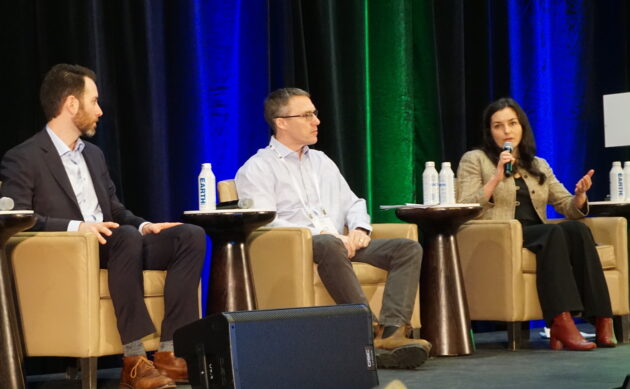
(L-R) PowerWood CEO Jake Power; Forsite’s Cam Brown; Jennifer Gunter from the B.C. Community Forest Association.
Innovative solutions for managing old-growth forests
We need quality old-growth stands to support biodiversity, said Forsite’s Cam Brown. Old-growth retention policies have been in place for decades, he explained, and maintaining old-growth does not preclude management. It is necessary to plan for long-term success to ensure the health of the ecosystem.
“Everything is connected – we should integrate planning of multiple values whenever possible.”
Jennifer Gunter from the B.C. Community Forest Association (BCCFA) said there are some 60 community forests in B.C., half of which are held by the First Nations. She also detailed the ecosystem-based management of old-growth, and the BCFFA recommendations to old-growth strategic review. This includes the need for community forest managers to be able to manage old growth to restore and maintain forest health and for community protection, especially in fire adapted ecosystems.
“Maintaining at least 51% mature and old forest combined – this will take time given the extent of past harvesting. Modeling may be needed to predict timber flows overtime,” she said.
Doing more with less was the focus of Jake Power’s presentation. The PowerWood CEO said his remanufacturing company has been adding value “all the way through, from when we plant.”
Power is a member of the B.C. Value Added Wood Coalition, which aims to “come up with solutions that will drive investment.” It is not easy, he said, as there are challenges such as the U.S.-Canada softwood lumber dispute, the high costs in B.C., and other hindrances that encourage capital investment in regions outside of B.C.
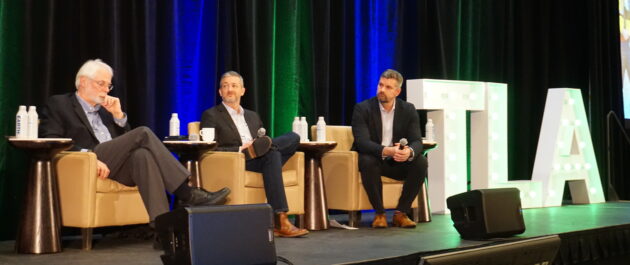
(L-R) Werner Kurz , senior research scientist, Pacific Forestry Centre; MNP’s Jason Fisher ; FPAC’s Derek Nighbor. Photo: Annex Business Media.
Moving the sector forward
There is a need to bring clarity to the science of carbon while looking at opportunity and need to invigorate the sector with new ideas, diverse strategies and innovation.
MNP’s Jason Fisher said forest management will be more effective than forest preservation in a world facing climate change. Forest management practices and products help mitigate climate change, he said, and have the potential to do more.
“I’m not here to give you answers, but to leave you with questions,” he said.
Werner Kurz , senior research scientist, Pacific Forestry Centre, said that in the context of climate change mitigation, we need to understand and enhance the role of forests as a mechanism to remove carbon dioxide from the atmosphere.
“If the land sector is to contribute to net zero pathways, then forest management has to refocus from producing timber and biomass to removing atmospheric carbon dioxide,” he said. The mitigation objective is to increase the net sinks in forests and the forest products sector, Kurz added.
Derek Nighbor, president and CEO of the Forest Products Association of Canada (FPAC), said Canada has many advantages, including the fact that “less than 25 per cent of our forests are available for harvest.” He added that only 11 per cent of the world’s forests are certified, but 77 per cent of Canadian forests are certified.
“There is some leadership happening in carbon storage here in Canada.”
Nighbor added that there’s an opportunity for Canada to be more competitive. Carbon price is going up by $15/tonne per year up to $170/tonne by 2030. There is growing uncertainty around equitable sharing of these revenues and impacts on private sector investment, he said.
“Not all carbon money collected goes back to whoever paid it – carbon paid by the forest industry may flow towards decarbonization of the steel industry and FPAC is lobbying against that,” he explained.
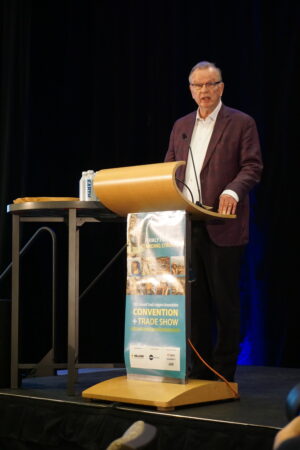
Minister of Forests Bruce Ralston. Photo: Annex Business Media.
Backbone of the economy
Closing the event was Minister of Forests Bruce Ralston, who proudly represented his riding of Surrey-Whalley.
“I have a little bit of cred when it comes to forestry. Do not underestimate North Surrey as we have an urban forest and a sawmill,” he joked.
Turning serious, Ralston acknowledged the people in the room saying, “You are definitely the backbone of the economy of B.C., and I really mean that.” He recognized that forest policies need to change and need to be modernized.
“We have to build an industry that is more sustainable and worry-free. I’m optimistic about what we can do together.”
Print this page